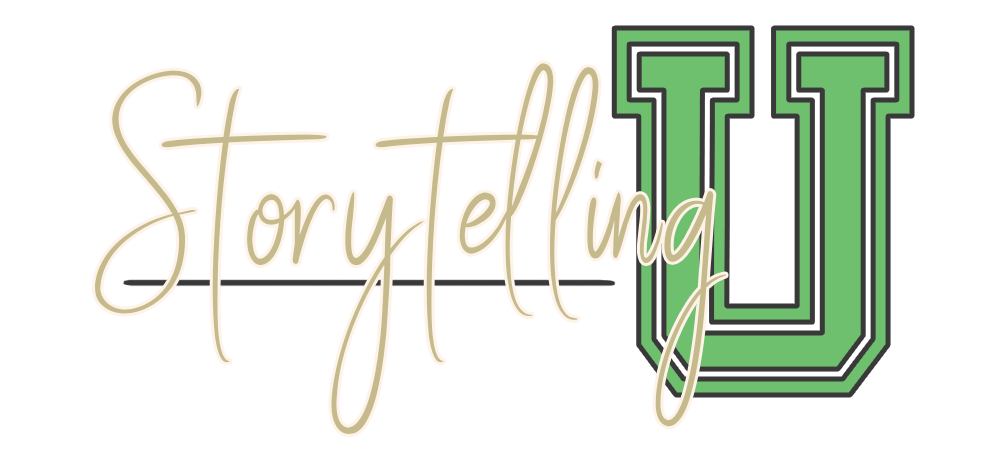Storytelling in Marketing:
How to leverage stories to captivate, connect, and convert
We’ve all heard the saying, “People don’t buy what you do, they buy why you do it.” And it’s true – people are more likely to be drawn in and converted by a story than by a list of facts or features about your product or service.

Stories are powerful. They have the ability to captivate, connect, and convert like nothing else. In fact, some of the world’s most successful businesses have leveraged storytelling in their marketing and sales efforts to great effect.
So how can you do the same for your business?
In this guide, we will explore the power of storytelling in marketing and discuss how you can use it to achieve your goals.
What is storytelling in marketing?
Storytelling in marketing is the use of stories to promote and sell a product or service. Stories are often used to connect with customers on an emotional level, which can lead to increased sales and loyalty.
Building a brand narrative
Your brand’s narrative is the story that you tell about your company. This can be done through advertising, social media, your website, and any other marketing materials.
Your brand narrative should be unique and memorable, and it should align with your overall business goals.
For example, if you’re selling a new type of product, your brand narrative could focus on how this product is different from anything else on the market.
Or, if you’re trying to appeal to a certain demographic, your brand narrative could focus on how your product or service meets their needs.
A strong brand narrative will help you to stand out from your competition and build a loyal customer base.
If you’re not sure where to start, try brainstorming some key points about your company that you want to communicate. From there, you can begin to craft a story that will engage and inspire your audience.
Remember, your brand narrative should be an ongoing story that evolves along with your business. So don’t be afraid to experiment and change it up as needed!
Think about the overall message you want to communicate, and make sure all of your marketing materials support this story. Your brand narrative should be cohesive and consistent across all channels.
This can be a lot of work, but it’s worth it to create a strong, memorable brand identity.
Using your brand narrative to inform your marketing messages
A strong brand narrative works as the foundation for your marketing messages. It should be the driving force behind everything you communicate to your audience, from your website copy to your social media posts.
The best marketing campaigns are multi-channel but cohesive, with a clear message that ties back to the brand’s core values. By using your brand narrative as a guide, you can ensure that all of your marketing materials support the same story and reinforce your identity.
It can be helpful to create some concrete messaging guidelines for yourself or your team, so everyone is on the same page about what kind of language to use when representing the brand.
This will keep your messages consistent and prevent any confusion about what your brand stands for.
With a strong, cohesive brand identity, you’ll be able to effectively communicate who you are and what you do – setting yourself apart from the competition. Investing in developing a well-rounded narrative will pay off in the long run by helping you build a strong, recognizable brand.
Using narrative-driven messaging to guide the customer journey
Every brand wants a customer to go on a specific journey when they interact with it.
This journey starts with becoming aware of the brand and what it has to offer, and ends with the customer making a purchase or taking some kind of action.
In order to guide customers through this journey, brands need to use narrative-driven messaging.
Narrative-driven messaging is a type of storytelling that uses specific plot points to lead the customer from one stage of the journey to the next.
For example, let’s say you’re a clothing brand targeting young adults.
Your goal is to get potential customers interested in your clothes so that they’ll eventually make a purchase. To do this, you might use narrative-driven messaging in your advertising campaigns.
You could tell a story about a young person who’s exploring their personal style and trying to find the perfect outfit for a big event. The story would start with the character feeling unsure about what to wear but eventually finding the perfect outfit at your store.
This would lead the customer from the Awareness stage to the Interest stage of their journey.
This kind of narrative is relatively basic and can seem bland until you weave in your particular brand narrative we mentioned earlier.
Your brand narrative is what makes your company unique and differentiates you from the competition. It’s the story that you tell about your brand, and it should be reflected in every aspect of your marketing.
For example, if you’re a sustainable fashion company, your brand narrative might focus on environmental consciousness or social responsibility.
You could use this same story about the young person shopping for an outfit, but rather than just finding a cute outfit, they find an outfit that reflects their values.
This would help customers understand how your clothing aligns with their own personal beliefs and make them more likely to want to support your company.
As you can see, crafting a strong brand narrative is essential to creating an effective marketing campaign.
The best way to connect with your target audience is to tell them a story that they can relate to on a personal level.
Why should you use storytelling in marketing?
Not that we’ve established what storytelling in marketing is, let’s look at why you should be using it, starting with the 3 C’s.
The three C’s stand for:
- Captivate
- Connect
- Convert
Used in concert, the three C’s make up the perfect storm of marketing success.
Let’s break each one down.
Captivate
In order to be successful, your story must first capture the attention of your target audience.
The best way to do this is by creating a relatable protagonist that your audience can relate to. Most companies have a target audience and are trying to provide them with goods or services to solve a problem they have.
Your story should focus on the problem your target audience has and how your company is helping them to solve it.
This will help to captivate your audience and keep them engaged with your story.
Connect
The second C, connect, is all about connecting with your audience on an emotional level.
Building an emotional connection with your audience is one of the most important things you can do as a business owner or marketer. It’s what separates the good from the great brands.
If you can tap into your audience’s emotions, you’ll create loyalty and brand advocacy that will last a lifetime. So how do you go about building this emotional connection?
To create an emotional connection with your audience, you need to tap into their desires and emotions. What do they want? What are they afraid of? What motivates them?
It all starts with understanding what your audience wants and needs. What are their motivations? What are their fears? Once you have a handle on this, you can craft a story that speaks to them on a deeper level.
It’s not just about what you’re selling, but why they need it. What will it do for them? How will it make their lives better?
Tapping into this emotional connection is key to building a strong brand narrative. So ask yourself, what story can you tell that will resonate with your audience and create an emotional connection?
Having a strong brand narrative is what anchors your connection with your audience and allows you to build deeper relationships. If you can tell a compelling story that speaks to their desires, you will forge an emotional connection that is hard to break.
Start there, and you’ll be well on your way to forging deeper relationships with the people who matter most to your business.
Convert
Converting your customers is the process of moving them along their customer journey from awareness to purchase. But it’s not enough to just get them to buy your product or service – you need to ensure that they are happy with their purchase and will continue to use your product or service over time.
This is where emotional connections come in. If you have forged a strong emotional connection with your customer, they are more likely to be loyal to your brand and continue doing business with you over time. So how do you create an emotional connection?
It starts with understanding what motivates your customers and crafting a story that speaks to their desires.
Once you’ve converted them, you need to deliver on your promise and provide them with an exceptional experience that leaves them wanting more.
If you can do this, you will create customers for life, and loyal repeat customers are key to increasing your conversion rates.
How to use storytelling in your marketing
As we’ve established, the power of storytelling lets you connect with, captivate, and then convert your audience.
It’s a way to stand out in a sea of marketing noise and make a lasting impression that will have your customers coming back for more.
Here are some tips on how you can use storytelling in your marketing:
Broadcast your story across multiple channels
Omni-channel marketing is all the rage these days, and for good reason.
Consumers are interacting with brands in more ways than ever before, so it’s important to meet them where they are. Customers are also more likely to remember a brand that tells a consistent story across multiple channels.
That’s where storytelling comes in. A well-crafted story can be adapted to work on any platform, whether it’s TV, social media, print, or even in-person events.
Think about how you can use storytelling in your marketing mix to reach your audience on all the channels they’re using.
Don’t forget about emotion
A good story will evoke emotions in your audience, which is essential for making a connection with them.
Think about what kind of emotions you want your customers to feel and build your stories around that. Do you want them to feel inspired? Empowered? Connected?
Overly emotional stories can be off-putting, so make sure you strike the right balance.
Make sure your stories are relatable
Your audience should be able to see themselves in your stories.
Whether it’s a shared experience or a relatable emotion, find ways to make your stories connect with your audience on a personal level.
This will make them more likely to remember your story and, more importantly, take action.
Storytelling works at many different points in the marketing funnel
The marketing funnel is the process that potential customers go through when they learn about, consider, and purchase your product or service.
At each stage of the funnel, a different kind of story will work best.
For example, at the top of the funnel (TOFU), you might use stories to generate interest and build awareness.
In the middle of the funnel (MOFU), you might use stories to establish your brand and differentiate yourself from competitors.
And at the bottom of the funnel (BOFU), you might use stories to close deals and drive conversions.
Think about the types of stories you can share
One of the primary benefits of storytelling in marketing is that it helps you connect with your audience on an emotional level.
When you can make an emotional connection with your prospects, they are more likely to remember your brand and do business with you in the future.
Some of the best stories to share in marketing are those that highlight:
Stories about the challenges your customers face help them feel seen and understood.
Your prospects will be able to relate to these stories and see how your product or service can help them overcome similar challenges.
Stories about the results your customers have achieved show the value of what you’re offering.
Your prospects will be able to visualize themselves achieving similar results, and this can help them make the decision to do business with you.
When sharing stories in your marketing, be sure to focus on the challenges your customers face, how your product or service solves those challenges, and the results your customers have achieved.
Pay attention to your tone
Remember, it’s not just about what you say; it’s also about how you say it
Your tone, style, and delivery are just as important as the actual words you use.
For example, if you’re selling a luxury product, your stories should be aspirational and elegant. If you’re selling a fun and quirky product, your stories should be playful and lighthearted.
Creating stories that specifically resonate with your target audience will go a long way in helping you connect with them on a deeper level.
The bottom line is this: no matter what kind of business you have, there’s a way to use storytelling to improve your marketing.
How to use storytelling in your copywriting
Copywriting and content marketing are two areas where storytelling can be particularly effective, so let’s take a look at how you can use good storytelling to power these aspects of marketing:
What is copywriting?
Copywriting is the art of writing persuasive, interesting content that encourages readers to take a specific action.
It’s used in everything from ads and email marketing campaigns to website content and blog posts.
Good copywriting is about more than just selling products or services – it’s about creating an emotional connection with your audience and getting them to see your business in a positive light.
What is content marketing?
Content marketing is all about creating and sharing valuable, relevant content to attract and engage your target audience.
It’s an ongoing process that helps you build relationships with potential and current customers by providing them with information that’s useful and interesting.
Content marketing can take many different forms, including blog posts, articles, infographics, ebooks, and more.
Why are content marketing and copywriting important?
The interconnected disciplines of content marketing and copywriting are important because they’re both focused on creating content that’s designed to engage and convert your target audience.
Content marketing is all about creating valuable, relevant content to attract and engage your target audience, while copywriting is all about crafting persuasive, compelling copy to get people to take action.
When you put the two together, you have a powerful combination that can help you achieve your business goals.
Here are four reasons why content marketing and copywriting are so important:
Reason # one: they help you build trust with your target audience
If you want to build a successful business, you need to build trust with your target audience. And one of the best ways to do that is through content marketing and copywriting.
When you provide valuable, relevant content to your target audience, you’re showing them that you understand their needs and problems. This helps to build trust and credibility with them.
And when you craft persuasive, compelling copy, you’re showing them that you have a solution to their problem. This also helps to build trust and credibility with them.
Reason # two: they help you generate leads
Content marketing and copywriting are also great for generating leads. When you create valuable content, people are more likely to share it with their friends and followers.
And when people share your content, it helps to increase your visibility online and attract more visitors to your website.
Plus, if you include a call-to-action in your content, you can generate leads by getting people to sign up for your email list or download a freebie.
Reason # three: they help you increase your sales
Content marketing and copywriting can also help you increase your sales. How? By helping you create more compelling sales pages and emails.
When you have strong copy on your sales pages, it’s easier to convince people to buy from you. And when you have great email copy, it’s easier to get people to open and click through to your website.
So if you want to achieve better results with your online business, start focusing on creating strong copy. It could be the difference between success and failure.
Reason # four: they help you build better relationships with your customers
Finally, content marketing and copywriting can help you build better relationships with your customers.
When you provide valuable content that helps people solve their problems, they begin to trust you. And when they trust you, they’re more likely to do business with you.
Where is copywriting used?
Copywriting is used in a variety of places, both online and offline.
Some of the most common uses for copywriting include:
How do stories strengthen copy?
Good narrative strengthens copy by making it more relatable, interesting, and persuasive. Through the use of story, we can connect with the reader on an emotional level, which can make them more likely to take action.
Think about some of the most memorable ads you’ve seen. Chances are, they told a story that resonated with you on some level. Even the Budweiser Wassup ad had an underlying narrative – friends getting together to have a good time.
Even if the marketing itself is as uncomplicated as a series of funny noises, there’s still a narrative arc being followed, and that narrative is what makes the ad so memorable and effective.
This is why narrative is such an important tool for copywriters. It allows us to connect with readers more personally and create ads that are more likely to stick in their minds. And when it comes to persuasion, there’s nothing more powerful than a good story.
What types of stories can you tell in copy?
As mentioned, one of the great strengths of leveraging the power of stories in marketing is the sheer breadth of stories you can tell.
You can tell stories that are
The sky’s the limit when it comes to the types of stories you can tell in marketing. However, there are a few things to keep in mind when crafting your stories.
- First, make sure your story is relatable to your target audience. The last thing you want is for your audience to feel like they can’t relate to your story.
- Second, ensure that your story is relevant to your product or service. You want your audience to see how your product or service can help them achieve their goals.
- Last, make sure your story is interesting. No one wants to read a boring story. Make sure your story hooks your reader and keeps them engaged until the very end.
How to use storytelling for public relations (PR)
Storytelling in PR is not new, but it is becoming increasingly important in the digital age.
As technology advances and news cycles move faster, people are looking for stories that add context and perspective to the events of the day.
PR professionals need to be able to tell these stories quickly, efficiently and in a way that resonates with their audience.
So, what is PR and how does it relate to marketing?
Public relations (PR) is the process of managing communication between an organization and its publics.
PR is about telling your organization’s story in a way that builds relationships and creates positive impressions.
It is important to remember that PR is not marketing.
Marketing is about creating demand for your product or service, while PR is about building relationships and creating goodwill.
While they are different disciplines, they can work together to create a more holistic communications program. Used in conjunction, PR and marketing can help you raise your brand’s visibility, credibility, and bottom line.
Storytelling helps you create a compelling media PR pitch
Compelling public relations pitches always have a great story at their core.
Your job as a PR professional is to find the stories that will interest your target audience and then craft a pitch that will get media attention.
Remember, you are not pitching the media on your organization or product–you are pitching them on a story.
To be successful, your pitch needs to be interesting, newsworthy, and relevant to the media outlet you are pitching.
If you can do all of those things, you will be well on your way to getting media coverage for your organization.
Storytelling helps you craft effective press releases
Being “on narrative” is much easier when you have a crystal clear idea of what your brand narrative is.
It should be clear, concise, and interesting–something that will capture the attention of your target audience.
Once you have a strong brand narrative, you can start to craft press releases that are in line with that story.
Remember, a press release is not an advertisement.
It’s a news story that should be interesting and relevant to the media outlet you are pitching. If you can do that, you will be much more likely to get the coverage you’re looking for.
That being said, good captivating storytelling is just as relevant to PR today as it was when your grandmother read the morning paper over breakfast.
The only difference is, now you have more tools at your disposal to get your story in front of more people than ever before.
It is a timeless way to communicate with others and can be used in any industry to help get your message across in an interesting way.
So, if you’re looking to give your press releases a little boost, consider working on your brand narrative first. It could make all the difference.
The power of storytelling
When it comes to marketing, stories are key. By crafting relatable, relevant, and interesting stories, you can hook your audience and keep them coming back for more.
The power of storytelling can be seen in many different industries, from the entertainment industry to product marketing.
In fact, some of the most successful brands have built their entire identity around a well-crafted story, and you can too!
By using storytelling in your marketing, you can connect with your audience on a deeper level and leave a lasting impression that will keep them coming back for more.
So what are you waiting for? Start crafting your brand’s story today!




